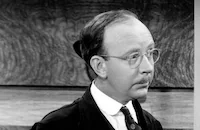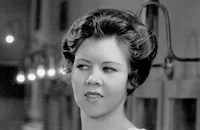I Live for Love

Brief Synopsis
Cast & Crew
Busby Berkeley
Everett Marshall
Dolores Del Rio
Guy Kibbee
Allen Jenkins
Hobart Cavanaugh
Film Details
Technical Specs

Synopsis
Actress Donna Alvarez insists that her lover, Rico Desaro, be cast as the lead in her new show. Producer Howard Fabian is not impressed with Rico's talents so he pretends they have already signed another actor for the part. When Donna demands to see him, Fabian produces singer Roger Kerry, who hopes to audition, but having forgotten his name, Fabian dubs Roger Owen Jones, and signs him as Donna's co-star. Donna is so opposed to Roger that she makes his life miserable and he quits. Roger goes back to singing with a group of street musicians and is heard by soap manufacturer George Henderson, who hires him to sing on his radio program. Meanwhile, Donna has gotten her own way and her new show is set to open with Rico as her co-star. Henderson arranges with Fabian for Donna to perform with Roger on the radio before the show opens. When Donna learns that Roger is the man she knew as Owen Jones, she walks out. Roger decides to make amends and attends her opening night. He is late, however, and completely disrupts the audience. The play is a failure, but Roger is determined to apologize for his actions. At a nightclub, he presents Donna with flowers, and Jim McNamara, his publicist, makes sure photographers are there to record the moment. When Donna's play closes, Henderson asks her to do a series of programs with Roger. The money he offers is so good that Fabian tricks her into agreeing. Henderson and Fabian arrange for Rico to travel to South America, and as a publicity stunt, they invent a romance between Donna and Roger. In the meantime, Donna and Roger fall in love for real. When the couple decides to get married, Fabian and Henderson realize they will lose their livelihood and send for Rico to break them up. Roger wants to marry Donna and live quietly, but she loves the public attention. They have a serious fight just as Rico returns, and Donna agrees to marry Rico just to spite Roger. Roger meets Donna at the church, however, and realizing that she loves Roger, leaves Rico standing at the altar.

Director

Busby Berkeley
Cast
Everett Marshall

Dolores Del Rio

Guy Kibbee

Allen Jenkins

Hobart Cavanaugh
Eddie Conrad
Shaw And Lee
Don Alvarado

Mary Treen
Robert Grieg
Mike Morita
Jane Froman
Jim Farley
Crew
Robert Andrews
George Barnes
Mort Dixon
Julius J. Epstein
Leo F. Forbstein
Bryan Foy
Esdras Hartley
William Mcgann
Terry Morse
Orry-kelly
Jerry Wald
Allie Wrubel

Film Details
Technical Specs

Articles
I Live for Love
By Violet LeVoit

I Live for Love
Quotes
Trivia
Notes
The film's working title was Romance in a Glass House. Daily Variety notes that William McGann directed the film's retakes. Everett Marshall, who made his second and last feature film appearance in this picture, was an operatic baritone and a popular radio performer. His first feature film was the 1930 RKO release Dixiana, which was directed by Luther Reed and starred Marshall and Bebe Daniels (see AFI Catalog of Feature Films, 1921-30, F2.1367).















